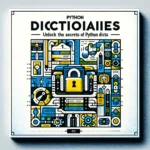Python is a powerful programming language that offers various features to simplify the development process. One such feature is the concept of booleans. In this article, we will explore booleans in Python, understand their significance, and learn how to leverage them effectively in your code.
Introduction
When working with programming, it is essential to understand the fundamental building blocks. Booleans are a data type that represents two values: True and False. These values are crucial in decision-making and control flow within a program. By mastering booleans in Python, you can enhance your coding skills and make your programs more robust and efficient.
Understanding Booleans
Booleans, named after mathematician George Boole, are logical values that can only be True or False. They are the basis for conditional statements and comparisons in Python. Booleans are often used to test conditions and determine the flow of execution in a program.
Booleans Variables
In Python, you can declare variables of boolean type by assigning the values True or False to them. For example:
is_valid = True
is_completed = FalseBoolean variables allow you to store and manipulate logical values, making your code more readable and self-explanatory.
Booleans Operators
Python provides several operators to perform logical operations on boolean values. These operators include AND, OR, and NOT. They allow you to combine or negate boolean values to create more complex conditions. For instance:
is_valid = True
is_complete = False
if is_valid and not is_complete:
print("Task is valid and incomplete.")Understanding and effectively using these operators will enable you to build powerful conditions in your programs.
Conditional Statements
Conditional statements are a vital part of programming, and booleans play a central role in them. In Python, conditional statements allow you to execute different blocks of code based on specific conditions. The if-else construct is commonly used for this purpose. Here’s an example:
is_raining = True
if is_raining:
print("Remember to take an umbrella.")
else:
print("Enjoy the sunny day!")By utilizing booleans in conditional statements, you can control the flow of your program based on real-world scenarios and conditions.
Looping with Booleans
Booleans are also useful when working with loops. Python offers various loop constructs like while and for loops, which can be controlled using boolean values. You can create loops that continue until a certain condition is met or iterate over a sequence while a specific condition holds true. Booleans serve as the controlling mechanism for such looping constructs.
Boolean Functions
Python provides built-in functions that return boolean values. These functions help you perform common operations and return results that can be used in conditional statements or boolean expressions. Examples of such functions include isinstance(), which checks if an object belongs to a specific class,and len(), which returns the length of a sequence. By utilizing these functions, you can add more flexibility and versatility to your code.
Practical Examples
To solidify your understanding of booleans in Python, let’s explore a few practical examples:
- Checking User Authentication: You can use booleans to verify if a user is authenticated before granting access to certain features or resources.
- Validating User Input: Booleans can help you validate user input by checking if it meets specific criteria or constraints.
- Handling Error Conditions: By using booleans, you can handle error conditions in your code and execute alternative paths when errors occur.
These examples illustrate how booleans can be used in real-world scenarios, highlighting their significance in Python programming.
Benefits of Using Booleans
Using booleans in your Python code offers several benefits:
- Simplicity: Booleans provide a straightforward and intuitive way to represent and work with logical values.
- Control Flow: Booleans allow you to control the flow of your program by executing different code blocks based on conditions.
- Readability: Boolean variables and expressions make your code more readable and self-explanatory, enhancing its maintainability.
- Efficiency: Leveraging booleans effectively can lead to more efficient code execution by reducing unnecessary computations.
By harnessing the power of booleans, you can write cleaner, more efficient, and error-free Python code.
Conclusion
In this article, we explored the concept of booleans in Python and how they can be leveraged in your programming endeavors. By understanding boolean variables, operators, conditional statements, looping constructs, and boolean functions, you have gained the necessary knowledge to use booleans effectively. Remember to consider the benefits of using booleans in terms of simplicity, control flow, readability, and efficiency.
Now that you have a solid foundation in mastering booleans in Python, it’s time to apply this knowledge to your own projects and witness the positive impact they can have on your code.
FAQs
A: No, in Python, booleans can only have the values True or False.
A: Yes, in Python, the boolean values True and False are case-sensitive.
A: Booleans are not typically used in mathematical calculations directly. However, they are essential for controlling the flow of execution in conditional statements and loops.
A: No, booleans are a fundamental concept in computer programming and are present in many programming languages, not just Python.
A: While it is possible to assign a boolean value to a variable of a different data type in Python, it is generally good practice to keep the variable types consistent to avoid confusion.


